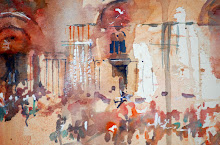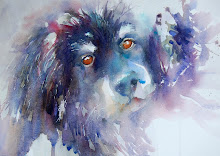Quick study : Observing and painting from a real daffodil
I have had a few messages from artist who want to paint daffodils but are finding them a challenge.
My top tip is to hold a real daffodil and study it. Let the colour you see guide where you place pigment to form the flower in watercolour. Observe the shapes of the petals. Try painting a single flower almost botanically before attempting to paint one in a loose style.
I originally was a Botanical artist, painting every fine detail in all of my watercolours years ago. That time taught me well on how to observe my subjects before trying to paint them. Now I work with colour, shape and wtaercolour techniques alone to bring my subjects to life without a preliminary sketch. But if you are new to painting and don't have this experience behind you it can be easy to get lost. Especially when working on painting things that are new to you.
Make life easy!
Choose good colours to tell the story. I am finding Daniel Smith Azo Yellow rather delicious for creating my Spring collection of daffodils. It isn't too strong a shade and is allowing me to work with it heavily diluted for the more transparent of the petals.
I have a vase of daffodils by my easel and I am painting each one, one at a time to discover colour options for shadows and merging sections where the petals meet
Painting flowers from life is ideal. Much better than painting from photographs alone which can lead to almost flat, lifeless results.
Once I am happy with painting a single subject it is then far easier to form a collection of ideas as a base for my future serious compositions.
On my easel today I have so much to learn and grow from. I have an exciting wash to add to gradually. I have two studies of single daffodils, both slightly different which is why I chose them. And I have a white piece of paper where I am painting the centres first before adding the petals. I also have two daffodils painted with them facing me full on at the top of my easel. Thats five paintings today. From just this morning.
These are all exciting pieces that have made me eager to paint a full painting now. With this preparative journey of exploration behind me I can now take a white sheet of clean fresh watercolour paper and begin to create a little more seriously. Without fear, as I know my subjects now, I know what colours I love best and I have fabulous techniques I can rely on to make my paintings unique to stand out.
A selection of paintings on my easel. An experimental journey to grow from as an artist.
The wash below is interesting as it will be a challenge to complete. Here I have placed colour all over the paper and later added centres. Next I need to add the outer petal edges then stop to decide what to paint to complete the piece. Washes without outlines can be the most fun to work on as you have no set format to work stage by stage. No pencil lines restrict you. You place colour simply where you feel it is needed to tell the story. There seems to be so much life and energy in this so far and I love looking at it during its' evolving development.
First wash with the centres of the flowers only added to define where they are.
Artists Tips
1) Paint from real life as often as possible to learn about your subject.
2) Choose the best colours possible to bring the real subject to life
3) Paint small individual studies before attempting a large composition
4) Experiment with ideas before painting a large piece.
5) Don't race your painting session,enjoy the journey of learning and improving your skill
*********
I now can't wait for tomorrow when I can start a whole new painting in the morning with all the ideas I have gained from painting today.
Happy painting!





























1 comment:
Thank you Jean for explaining your preparation steps! Lately I've been rushing trying to create paintings for a show, with many turning out badly or at least not matching my vision, and wondered if I lost my touch. I did decide to go back to basics and do more prepping and to read about your steps gives me great relief and inspiration. Many thanks for your continuous generous sharing and support! Many people don't know how much work goes on behind the scenes of a painting. They think you just crank them out and are filled with wonder and awe. It takes just as much practice to do nice paintings as it does to play an instrument, a sport, or to knit a sweater, or a million other things!
Post a Comment